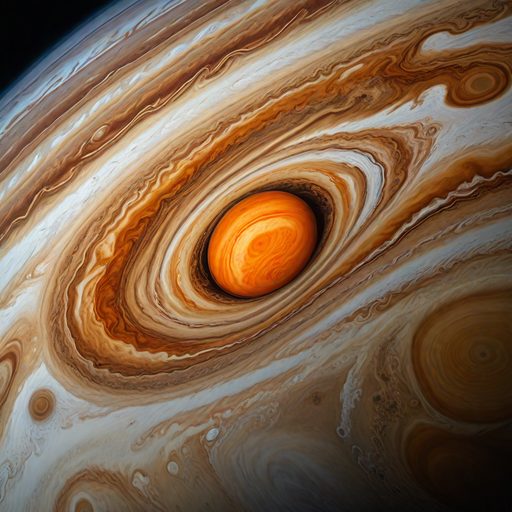
Jupiter: New Research Reveals Great Red Spot’s Secrets
Recommended for Astronomy & Space
Jupiter, the colossal gas giant, is a world of wonder. Amidst its swirling clouds and mesmerizing bands lies a guiding light of fascination: the Great Red Spot (GRS). A storm of epic proportions, this iconic crimson oval has captivated astronomers for centuries.
But what secrets does this enigmatic spot hold?
Join us on a journey through time and space as we explore the mysteries of Jupiter’s Great Red Spot.
A massive, long-lasting storm on Jupiter, visible as a red oval.
It's larger than Earth, big enough to swallow our entire planet!
Yes, observations show it has been shrinking over the past century. What is the Great Red Spot?
How big is the Great Red Spot?
Is the Great Red Spot shrinking?
A Storm Born of Mystery
Imagine a hurricane, not on Earth, but on a planet so vast that its storms dwarf anything we’ve ever seen. The Great Red Spot is such a storm, a swirling vortex of gases larger than any other in our solar system. Its winds howl at speeds that would make a tornado blush, and its crimson hue is a mystery yet to be fully solved.
The GRS is not just a storm; it’s a time capsule of Jupiter’s atmosphere. It’s been churning for centuries, perhaps even longer, offering a glimpse into the complex weather patterns of this giant planet. But the GRS is not static; it changes over time, its size and shape shifting like a living entity.
The story of the GRS begins in 1665 when astronomer Giovanni Cassini first observed a dark spot on Jupiter. This spot, however, disappeared and was not seen again for over a century. Was it the same as the GRS we see today, or was it a different storm that faded into oblivion? The answer lies in the winds of Jupiter.
The Winds of Change
Jupiter’s atmosphere is a complex ballet of swirling gases, driven by powerful winds and immense heat from within the planet. The Great Red Spot is caught in this dance, a swirling vortex confined to a specific latitude by jet streams. These jet streams, like invisible fences, keep the storm in its lane, allowing it to persist for centuries.
But the GRS is not invincible. Observations over the past century show it’s been shrinking, its once-vast oval shape becoming more circular. This change is a reminder that even the most powerful storms are not immune to the forces of nature. The question is, how long will the GRS last?
The disappearance of Cassini’s spot and the shrinking of the GRS suggest that these storms are not eternal. Perhaps the GRS we see today is a new storm, born from the turbulent depths of Jupiter’s atmosphere. And if so, what does the future hold for this iconic feature?
The Great Red Spot’s Legacy
The Great Red Spot is more than just a storm; it’s a window into the complex workings of Jupiter’s atmosphere. By studying the GRS, scientists can learn about the planet’s wind patterns, temperature variations, and chemical composition. This knowledge helps us understand not only Jupiter but also other gas giants in our solar system and beyond.
The GRS is a testament to the power of nature, a reminder that even the most massive planets are subject to change. Its shrinking size may be a sign of its eventual demise, but it also signals the possibility of new storms emerging, perhaps even more powerful than the GRS.
Despite centuries of observation and study, the Great Red Spot remains an enigma. Its origins, its color, and its future are still shrouded in mystery. But this is what makes it so fascinating, a constant reminder that there is still so much to learn about our universe.
The Great Red Spot, like a wise old sage, has witnessed the passage of time on Jupiter, its story etched in the swirling clouds. It is a symbol of the planet’s dynamic nature, a reminder that even the most iconic features are not immune to change. As we continue to explore the mysteries of Jupiter, the Great Red Spot will undoubtedly continue to captivate and inspire us, reminding us of the vastness and complexity of our universe.
Watch a video
Unravel the mystery behind Jupiter’s colossal crimson storm.
Curious Times is a leading newspaper and website for kids. We publish daily global news aligned to your learning levels (also as per NEP 2020): Foundational, Preparatory (Primary), Middle and Senior. So, check out the News tab for this. We bring kids’ favourite Curious Times Weekly newspaper every weekend with top news, feature stories and kids’ contributions. Also, check out daily JokesPoke, Tongue Twisters, Word of the Day and Quote of the Day, kids need it all the time.
Curious Times News Program for Schools for FREE. Over 5,000 schools and teachers from all over the world have joined our programme so that students and teachers can get FREE Educative Newspaper. Here, kids can take part in world events and win prizes and certificates for free through their schools.
Moreover, schools are sharing important School News, like interviews with the principal, notices about new students, contests, and results, not just on social media but also on a news website for kids and other schools.
Thus, do not wait any further, sign-up for your school for FREE.
The following social media platforms allow you to communicate with us: WhatsApp, Instagram, Facebook, Youtube, Twitter, and LinkedIn.
0 (Please login to give a Curious Clap to your friend.)
